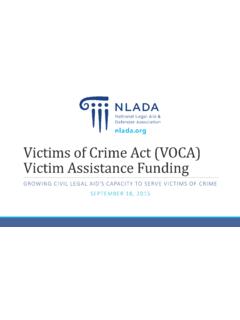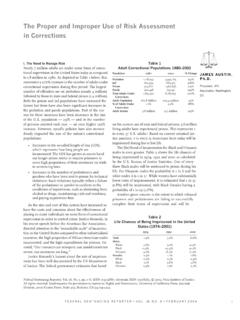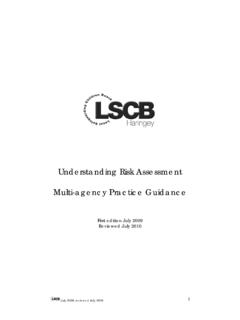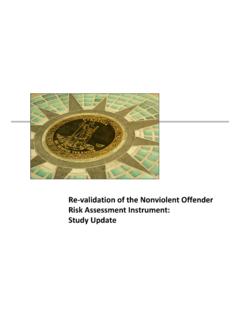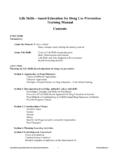Transcription of Risk & Needs Assessments - nlada100years.org
1 & Needs Assessments : What Defenders and Chief Defenders Need to Know July 2015 PAGE3 National Legal Aid & Defender AssociationRisk & Needs Assessments : What Defenders and Chief Defenders Need to Know Risk & Needs Assessments : What Defenders and Chief Defenders Need to KnowI. IntroductionA significant movement in criminal justice is the use of actuarial risk Assessments and Needs Assessments to make decisions about persons at various stages of the criminal justice system. This report provides basic information about these types of Assessments and summarizes the potential challenges and opportunities that these Assessments carry for defenders (both for individual attorneys and for chief defenders).The risk and Needs Assessments employed at different decision points in the criminal process focus on different salient factors. A pretrial risk assessment seeks to measure the likelihood that a person will fail to appear for court or commit an offense while officers may use a risk assessment to determine whether to arrest or issue a citation.
2 A presentence risk assessment addresses the likelihood that a person will reoffend or violate the condition of supervision. Prosecutors may rely on an assessment to guide filing charges or referring to an alternative court. Courts may rely on presentence Assessments in declaring a prison sentence or alternative to incarceration. Post-sentence risk Assessments , most frequently employed by corrections and parole officials, may inform classification, programming, release, and revocation decisions. Needs Assessments evaluate the characteristics of the person that, if properly addressed, will reduce the risk of future misconduct. Needs Assessments can inform decision makers whether a person in the criminal justice system requires mental health care, drug treatment, et al. II. Potential Benefits of Risk and Needs AssessmentsThe increased use of risk and Needs Assessments reflects a growing body of research showing that [w]hen developed and used correctly, these risk/ Needs assessment tools can help criminal justice officials appropriately classify offenders and target interventions to reduce recidivism, improve public safety and cut costs.
3 1 Assessments are the starting point for the Risk-Need-Responsivity model for the treatment of those The goals of this model are 1. to assess the risk of re-offending; 2. assess the person s Needs in relation to risk factors for re-offending; and 3. provide treatment focused on cognitive social learning in a manner taking individual personality and demographics into Research has shown that adherence to all three principles is associated with greatest reduction .. in the recidivism rate. 4 Research has identified specific risk factors for future criminal conduct, some of which are static (permanent) and some of which are dynamic (subject to change). Examples of static factors are age at first arrest, history of missing court (if present), and number of prior convictions (the number could change, but is generally static while the person serves a sentence).5 Dynamic factors are factors associated with criminal behavior that can be changed, at least for many, through effective Risk/ Needs assessment 101: Science Reveals New Tools to Manage Offenders, p.
4 1 (Pew Center on the States 2011).2 See generally James Bonta and Andrews, Risk-Need-Responsivity Model for Offender assessment and Rehabilitation (Public Safety Canada 2007); Pamela Casey, Roger Warren, & Jennifer Elek, Using Offender Risk and Needs assessment Information at Sentencing: Guidance for Courts from a National Working Group, pp. 4-6 (National Center for State Courts 2011).3 Bonta and Andrews, Risk-Need-Responsivity Model for Offender assessment and Rehabilitation, see above n. 2, p. Casey, Warren, & Elek, Using Offender Risk and Needs assessment Information at Sentencing, see above n. 2, p. 6. ; Andrews and James Bonta, Rehabilitating Criminal Justice Policy and Practice, 16 Psychology, Public Policy, and Law 39, 47-48 (American Psychological Association 2010) (reviewing numerous studies comparing outcomes of programs using the Risk- Needs -Responsivity model to other justice programs).
5 5 Risk/ Needs assessment 101, see above n. 1, p. 2 (citation omitted).6 Risk/ Needs assessment 101, see above n. 1, p. 2 (citation omitted).PAGE4 National Legal Aid & Defender AssociationRisk & Needs Assessments : What Defenders and Chief Defenders Need to Know An effective assessment allows justice officials to make evidence-based, informed decisions regarding programming. For example, intensive treatment programs work significantly better for those evaluated as high risk than for those evaluated as low Therefore, if combined with the availability of effective community-based programming, risk and Needs Assessments may provide defense counsel with recidivism alternatives to prison for some high-risk people, while also supporting arguments to divert low-risk people without onerous conditions of important component of successful treatment for those involved in the criminal justice system is the principle of responsivity, which calls for providing services in ways that match individual learning styles and Defenders should have at least general familiarity with this principle.
6 Because an individualized approach to programming may significantly reduce the percentage of those people who face sentencing or revocation of supervision after being discharged from Potential Harm to Clients from Risk and Needs AssessmentsDespite the potential benefits summarized above, risk and Needs Assessments can have detrimental effects upon people involved in-cjsyst. This section outlines the following ways in which Assessments can be harmful person: statements made during the assessment interview are used against the client;9 assessment instrument is not valid for population in question; assessment instrument is not used for intended purpose; assessment instrument is not administered properly; assessment identifies Needs for which community-based programming is not available; assessment instrument fails to consider how social factors (like racial discrimination) impact apparently neutral risk factors (like age at first arrest).
7 Assessments administered without safeguards against implicit bias, thus potentially increasing disproportionate minority Statements made during the assessment interview must not be used to prosecute or otherwise punish the the an agreement approved by the court or otherwise carrying the force of law that statements made in connection with the assessment will not be used to support criminal charges, revocation of supervision, or other adverse government action, every defendant should be advised of the Fifth Amendment right against self-incrimination before answering 7 Risk/ Needs assessment 101, see above n. 1, p. 4. Without research demonstrating the value of providing treatment for a high-risk population, justice officials might logically assume that the best chance for success is with low-risk participants. Because the population is by definition low risk, most participants would not reoffend, thus reinforcing confidence in the program.
8 However, the program might actually increase recidivism in a population that would do even better without treatment. Conversely, intensive treatment generally has the greatest positive impact on a high-risk population. Risk/ Needs assessment 101, see above n. 1, p. 4. See also Shelli Rossman and Janine Zweig, The Multisite Adult drug Court Evaluation, p. 6 (National Association of drug Court Professionals May 2012) (treatment courts achieve higher reductions in recidivism and greater cost savings when participants are high-risk individuals who would otherwise serve prison time).8 See Bonta and Andrews, Risk-Need-Responsivity Model for Offender assessment and Rehabilitation see above n. 2, p. 1. A simple example of the responsivity principle is that if treatment participants are missing sessions because of work schedules or child care, the treatment provider might respond by finding a different time that is more convenient.
9 See Bonta and Andrews, Risk-Need-Responsivity Model for Offender assessment and Rehabilitation, p. 7. Similarly, if a client has difficulty understanding abstract concepts, the treatment sessions should consist of practicing the desired behaviors, rather than of discussing broad principles. The more advanced pretrial risk Assessments , as employed in Kentucky and an increasing number of states, do not require interviews. See Marie VanNostrand and Chrisopher Lowenkamp, Research Report: Assessing Pretrial Risk Without a Defendant Interview (Laura and John Arnold Foundation, November 2013) .10 The Constitutional privilege against self-incrimination applies to the use of risk assessment instruments because the privilege not only applies before or at a criminal trial, but also protects against self-incrimination in any other proceeding, civil or criminal, formal or informal, where the answers might incriminate [the person] in future criminal proceedings.
10 Minnesota v. Murphy, 465 420, 426 (1984) (citation omitted). The privilege against self-incrimination extends beyond answers that would in themselves support a conviction, applying also to those that would furnish a link in the chain of evidence needed to prosecute. Ohio v. Reiner, 532 17, 19 (2001). However, these cases do not fully protect the defendant from harm, as they apply the exclusionary rule prohibiting introduction of statements in the criminal justice context. Statements captured by interview based risk Assessments could gravely impact a person outside of the criminal case if used, for example, in immigration court. There is no obvious court rule or statute that protects statements made in a risk assessment interview from introduction in a civil or immigration Legal Aid & Defender AssociationRisk & Needs Assessments : What Defenders and Chief Defenders Need to Know A risk assessment instrument may ask about a defendant s use of illegal drugs, knowledge of drug availability, or association with drug Answers to such questions may reveal incriminating evidence that authorities may use in drug offense prosecution or in other adverse government action affecting child custody, immigration or other civil the purpose of using the assessment is to facilitate informed and effective decision-making in the justice system, the parties involved should agree that statements made during assessment interviews will not be used in investigations of the defendant to initiate prosecutions or in criminal prosecutions to prove specific charges or Counsel must also be able to advise whether defendant s responses could be used to impose adverse civil consequences.
